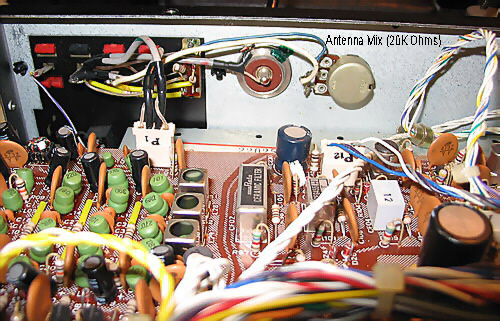for the
FRG-7700
Analysis: Feeding the SW port only, causes a 36 dB loss when you tune the BC band. Feeding just the BC input gives you virtually no signal for the SW bands. I tried several design approaches in an attempt to "unite" these two inputs. On the test bench, several measurements were made in each condition, on each band, with every permutation possible. The final verdict was boiled down to a simple option of mixing the two input filter sections with, either (A) a fixed resistor (50 to 200 Ohms)* or (B) a variable resistor (20 K Ohm potentiometer).
Since I already have electro-OCD, I decided to drill the chassis and go for the full flexability by using a "mixing pot."
*(Use a carbon composition or carbon film type, not a wirewound resistor)

Operation: The advantage of the pot over the fixed resistor is that you may adjust it for either maximum signal on BC or for minimum loading and noise on SW. The differences are miniscule and barely noticeable under most conditions, but they are visible on the test bench and can be heard under some extreme listening conditions.
Turning the pot to zero ohms, which shorts the two inputs together, provides maximum signal transfer for BC, but may add a small amount of (mismatch) noise while tuning SW.
Conversely, increasing the pot's resistance to, say, 10 or 15 K Ohms, isolates the SW filter section of the RF amplifier stage, and provides the cleanest signal, but, as mentioned above, will cause a significant signal attenuation on AM (MW), B'cast.
The fixed resistor mod is a good compromise, and the less-than-fanatic user will probably never notice any deficiency, nor desire anything more in performance.
You can easily try the resistor route first, by simply inserting it into both ports. Listen to all the bands with the resistor in, with the ports shorted, and with both ports opened. This is easily accomplished with a couple of clip leads connected to the two ports and quickly trying all three conditions. It is my feeling that, your antenna, a particular station's signal strength, and/or your location, will dictate whether you make the simple mod or the variable one.
... use common sense, and remember to unplug your soldering iron when you are done!
Happy listening.
Bob
